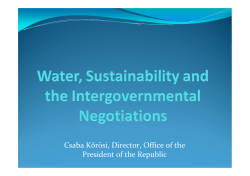
GridTech Project, Hans Auer
Hans Auer Energy Economics Group (EEG) Vienna University of Technology Overview of the GridTech Project The sole responsibility for the content of this presentation lies with the authors. It does not necessarily reflect the opinion of the European Union. Neither the EACI nor the European Commission are responsible for any use that may be made of the information contained therein. About the project GridTech is a project co-funded by the European Commission under the Intelligent Energy Europe Programme. Contract number: Duration: May 2012 - April 2015 IEE/11/017 / SI2.616364 Full title: Impact Assessment of New Technologies to Foster RESElectricity Integration into the European Transmission System Budget: 1,958,528 EC contribution: 1,468,896 About the project GridTech’s main goal: Conduct a fully integrated assessment of new grid-impacting technologies and their implementation into the European electricity system. This will allow comparing different technological options, towards the exploitation of the full potential of future electricity production from renewable energy sources (RES-E), with the lowest possible total electricity system cost. Project structure Transmission expansion: non-technical barriers RES integration: market issues Innovative technologies screening Cost-benefit methodology Pan-European study (top-down approach) Regional case studies (bottom-up approach) Results and recommendations Grid-impacting technologies (overview) • Onshore and offshore wind energy • Large-scale solar technologies: Concentrated Solar Power (CSP) and Photovoltaics (PV) Electricity generation technologies, with a focus on variable RES-E • Pumped Hydro Energy Storage • Compressed Air Energy Storage Bulk energy storage technologies Demand Response Technologies/ Measures and electric vehicles • HVDC - High Voltage Direct Current, both VSC (Voltage Source Converter)based and CSC (Current Source Converter)-based • FACTS - Flexible Alternating Current Transmission System • PST - Phase Shifting Transformers • WAMS - Wide Area Monitoring System • DLR - Dynamic Line Rating-based OHLs • HTLS - High Temperature Low Sag Conductor-based OHLs Transmission technologies directed at improvements in network control and flexible electricity system operation 2020 and beyond Within the 2020, 2030 and 2050 time horizons, the aim is to assess, among innovative technologies, i) which, ii) where, iii) when, and iv) to which extent they could effectively contribute to the further development of the European transmission system … fostering the integration of an everincreasing penetration of RES-E generation 2030 2020 2050 … and boosting the creation of a pan-European electricity market, while maintaining competitive and sustainable electricity supply. Scenario definition Scenario/year 2020 2030 2050-1 (with PTDF) 2050-2 (without PTDF) S0 (baseline) base TGT-2020 base EST-2020 base EDT-2020 base TGT-2030 base EST-2030 base EDT-2030 base TGT-2050 base EST-2050 base EDT-2050 base TGT-2050x base EST-2050 base EDT-2050 S1 (TGT-oriented) base TGT-2020 base EST-2020 base EDT-2020 advanced TGT-2030* base EST-2030 base EDT-2030 advanced TGT-2050* base EST-2050 base EDT-2050 advanced TGT-2050x base EST-2050 base EDT-2050 S2 (EST-oriented) base TGT-2020 base EST-2020 base EDT-2020 base TGT-2030 advanced EST-2030 base EDT-2030 base TGT-2050 advanced EST-2050 base EDT-2050 base TGT-2050x advanced EST-2050 base EDT-2050 S3 (EDT-oriented) base TGT-2020 base EST-2020 advanced EDT-2020 base TGT-2030 base EST-2030 advanced EDT-2030 base TGT-2050 base EST-2050 advanced EDT-2050 base TGT-2050x base EST-2050 advanced EDT-2050 *: by application of MTSIM planning modality x: by use of commercial flows Pan-European study Pan-European zonal model (2030, potential/updated) Pan-European model: 2030 S0 inputs Total generation capacity at 2030 (derived from an extended ENTSO-E 2030 V3 scenario): • Nuclear 108.6 GW • Lignite 56.6 GW • Hard Coal (incl. CCS) 76.5 GW • Gas (CCGT, OCGT, ST) (incl. CCS) 311.2 GW • Oil/oil shale 16.6 GW • Other non RES (CHP, waste) 53 GW • Hydro (ROR, reservoir, PHES) 297 GW • Wind (onshore, offshore) 373.7 GW • Solar (PV, CSP) 243.2 GW • Other RES (biomass, geothermal, tidal, wave) 78.1 Total load demand at 2030: 4772 TWh Total inter-zonal HVAC capacity: 131.0 GW Total inter-zonal HVDC capacity: 32.7 GW Total bulk storage (PHES, SPHES): 71.5 GW GW Pan-European study results (2030 S0, base) Main (updated) outcomes: Load shedding is null RES curtailment (9.4 TWh) is rather high Zonal marginal costs are higher than in 2020 HVDC corridors are rather fully utilised The system needs reinforcements across British islands, in Balkan, Iberian and Baltic regions, on north-south Central Europe axis and around isolated zones 2030 S0 (base) results: RES curtailment 2030 S0 (planning) results: expansion needs HVDC expansions (up to 5000 MW): • ES-FR (5000 MW, VSC USC) • GB-FR (5000 MW, VSC USC) • GB-IE (1338 MW, VSC USC) • CY-TR (409 MW, VSC USC) • SE-DE1 (1341 MW, CSC USC) • IE-IS (915 MW, CSC USC) • GB-NO (1014 MW, CSC USC) Pan-European study results (2030 S1, TGT) Main outcomes: Load shedding is null High benefits are brought by TGT (HVDC) in terms of RES curtailment reduction (7.5 TWh) and dispatch cost decrease (4.6 b€) with respect to 2030 S0 Zonal costs are changing depending on countries, RES penetration, energy mix Impact of TGT (HVDC) on CO2 emission leads to ca. 0.28 MtCO2 emission reduction HVDC corridors are rather fully utilised Pan-European study results (2030 S2, EST) EST capacity expansions over 2030 S0: New PHES capacity: 3890 MW (in CY, EE, TR) Expanded PHES capacity: 4424 MW (in FR, LT, NO, PL) New SPHES capacity: 3143 MW (in IE, IT) New CAES capacity: 2225 MW (in DE1, ES, NI) Main outcomes: Load shedding is null RES curtailment is reduced (by 1.44 TWh) due to EST effect Dispatch cost reduction amounts to 800 M€ with respect to 2020 S0 CO2 emissions reduction by EST: 0.41 MtCO2 Pan-European study results (2030 S3, EDT) Main outcomes: Load shedding is null EDT (DR) brings higher benefits than in 2020 in terms of RES curtailment reduction (1.4 TWh) and dispatch cost reduction (1.34 b€) over S0 (base) Zonal costs are changing depending on countries, RES penetration, energy mix Impact of EDT (DR) on CO2 emissions variation is negative (CO2 emissions increase: 7.4 MtCO2) Pan-European study Pan-European zonal model (2050, potential/updated) 2050-1 S0 (base) results: RES curtailment 2050-1 S0 (planning) results: expansion needs HVDC (onshore) expansions (100-10000 MW): • DE1-DK (6048 MW, VSC USC) • GB-FR (10000 MW, VSC USC) • GB-IE (1463 MW, VSC USC) • CY-TR (771 MW, VSC USC) • FR-IT (9819 MW, VSC UGC) • EE-FI (822 MW, VSC USC) • GB-BE (10000 MW, CSC USC) • GB-NL (3238 MW, CSC USC) • GR-IT (4245 MW, CSC USC) • NO-DK (9500 MW, VSC USC) • SE-DE1 (5192 MW, CSC USC) • SE-LT (1740 MW, VSC USC) • IE-FR (9741 MW, VSC USC) • GR-TR (10000 MW, VSC OHL) • RO-TR (2515 MW, CSC USC) • AT-SK (309 MW, VSC UGC) • DE1-AT (2460 MW, VSC OHL) HVAC expansions (100-10000 MW): • BG-TR (4653 MW, OHL) • LT-LV (481 MW, OHL) • LT-PL (3093 MW, OHL) TGT/EST/EDT Benefits TGT benefits 2030 2050-1 (with PTDF) 2050-2 (without PTDF) Dispatch cost reduction 4562 M€ 191 b€ 174 b€ RES curtailment reduction CO2 emissions reduction 2050-1 (with 7774 PTDF)GWh 2050-2 (without PTDF) EST benefits 7456 GWh 2030 8822 GWh Dispatch277 cost ktCO2 reduction 54516 ktCO2 800 M€ 57116 ktCO2 871 M€ 36229 GWh 1444 GWh 33024 GWh 3665 GWh 3515 GWh CO2 emissions reduction 412 ktCO2 1831 ktCO2 1810 ktCO2 Load shedding reduction 0 GWh -6 MWh 0 MWh Load shedding RES curtailment 0 GWh reduction reduction 848 M€ Target countries AUSTRIA BULGARIA GERMANY IRELAND ITALY NETHERLANDS SPAIN In addition to top-down modelling on EU30+ and taking stock from it in a consistent data input-output flow, GridTech focuses on 7 countries, representative of the existing and future European electricity systems, studied at 2020, 2030 and 2050 by detailed grid/zonal analyses. Summary: Technology Focus in Target Countries Country 2020 2030 2050 Spain FACTS DSM Storage HVDC Morocco-Spain-France EVs DSM Ireland HVDC VSC LCC vs. AC (onshore and offshore) in combination with storage Storage (other) DSM DSM Smart Grids HVDC overlay grid Smart Grid + DSM Storage (large scale) HVDC overlay grid (offshore and onshore) Smart grid + DSM HTLS The Netherlands DLR Italy HVDC interconnector HTLS HVDC Interconnectors Smart Grid + DSM Storage HVDC Storage Austria HVAC line Salzburg Storage (PHS) HVAC line Storage (PHS) HVDC line (AT-SK) DLR and FACTS Storage (PHS) Bulgaria DLR HTLS Storage (hydro) DSM Batteries, EVs, PHES DLR HVAC Storage (battery) EVs DSM Germany First HVDC Projects Expansion of HVDC Lines to a meshed grid Storage plants European on and offshore HVDC grid Smart Grids 90% 80% 2014 70% 60% 50% 40% 30% 2020 20% 10% 8500 8000 7500 7000 6500 6000 5500 5000 4500 4000 HVDC line DSM+EV 3500 2050 3000 DSM and CAES storage 2500 2030 2000 FACTS device to solve local constraints 1500 2020 1000 0% 0 Grid Technology Focus ES->MO 100% 500 8760 hours simulation Full transmission network MO->ES Unconstrained power flow (% of transfer capacity) Spanish Case description Power flow in the interconnection Power flow limits in South Spain MO@2020: 11GW RES vs. 7.5 GW load Scenarios for RES importing by Spain (3,013 hours) Demand RES Number of hours Additional hourly RES imports (MW) 90% 70% 10 0 80% 40% 7 100 80% 20% 194 200 70% 80% 47 400 65% 50% 284 500 65% 10% 589 600 40% 20% 1,882 0 400 300 200 Adapted RES generation curve Annual operation benefits 100 GWh Selected results for 2020 scenario Results 0 Nuclear -100 Thermal Conventional RES generation hydro (including PHES) PHES Consumption -200 -300 -400 30M€/year savings vs. 5-10M€ investment Dutch Case description Dutch 380 kV network Focus: transporting large amounts of offshore wind power located in the West coast to the East side of the country via the onshore network 2030 solutions BASE Current capacity (3,000A) A DLR (4,000A, depending on weather conditions) B Capacity upgrade (4,000A) C 4,000 A + 4,000 A HVAC line D 4,000 A + 1,000 MW HVDC line E 4,000 A + 2,000 MW HVDC line Red line: represents the corridor limiting the West (Randstad area) – East (rest of the Netherlands) flow Congestion characteristics Number of hours Energy 8000 7000 12000 6000 10000 5000 GWh 8000 Hours Selected results for 2030 scenario 14000 4000 6000 3000 4000 2000 2030 solutions 2000 1000 BASE Current capacity (3,000A) 0 A DLR (4,000A, depending on weather conditions) B Capacity upgrade (4,000A) C 4,000 A + 4,000 A HVAC line D 4,000 A + 1,000 MW HVDC line E 4,000 A + 2,000 MW HVDC line Base A-2030 B-2030 C-2030 D-2030 E-2030 0 Base A-2030 B-2030 C-2030 D-2030 E-2030 Conclusions and Policy Recommendations 1. Transmission expansion and implementation of grid-impacting technologies are cost-effective solutions and significantly contribute to the 10% electricity interconnection target of the European Union by 2020 and the tentative 15% target by 2030. 2. Short-term (2015-2020), grid-impacting technologies like FACTS and DLR are cost-effective solutions to increase the use of existing transmission capacity and to avoid transmission network congestion and RES-E curtailment. Therefore, providing adequate incentives for TSOs to invest in this type of technology is recommended. 3. Mid-term (2020-2025), DSM and energy storage technologies increase system flexibility and contribute to the integration of larger amounts of RES-E production and reduction of system operation costs. Both have strength in terms of benefits to the system (DSM very cost-effective; storage in congested/island regions). In addition, the distribution of benefits among market participants will not be the same in the two technology cases (many customers (DSM) versus few storage owners (storage)). 4. Long-term (2025-2030), significant transmission expansions are necessary in the European electricity system. When having in mind the 10% interconnection target by 2020 (15% by 2030) the GridTech analyses clearly indicates that the fulfilment also depends on future RES-E capacity installations. Therefore, it is necessary to implement corresponding incentives that both policy ambitions are met simultaneously, future interconnection and RES-E targets. 5. Very long-term (beyond 2030), the development of HVDC networks can play a significant role for RES-E integration. However, also the availability and roll-out potential of smart grid solutions needs to be considered. Therefore, it is very important that TSOs and DSOs start cooperating in Europe already right now. 6. Legislation and regulatory procedures for upgrading existing and/or implementation of new transmission projects needs to be further harmonized across Europe and within Member States and lead times need to be shortened (“one-stop-shop”). 7. Active incorporation/involvement of local people/communities is very important to reach consensus and to overcome the so-called “NIMBY” effect ultimately resulting in faster realisation of important transmission projects. Interconnection Targets – Energy Union Map of interconnection levels in 2020 after implementation of current PCIs GridTech result for scenario 2020 S0 Source: EC COM(2015) 82. GridTech result for scenario 2030 S1 GridTech result for scenario 2050 S1 Synthesis/Recommendations: Pan-European Study There are several technological options available today and in the future: tailor-made solutions depend on the specific cases/regions (local/regional situation important) Large investments and electricity system extensions are needed to foster huge RES-E integration HVDC technologies have performed very effectively From a welfare perspective, the use of DR is supposed to be very effective -> price signals to industry and customers are needed Energy storage may be less effective to improve system behavior in less congested systems -> this depends on the fact that storage needs constraints to be put in operation and the pan-European case reflects a quite ideal situation while the regional case studies with grid constraints may see a wider storage application One good exception in terms of energy storage is the case of islands (like Ireland ) where storage (PHES, SPHES) can strongly impact and help systems with interconnection capacity gaps Storage vs. DR -> DR may be favoured in less congested systems over storage as it is generally cheaper and more efficient; benefits for storage see above Flexibility, controllability and socio-environmental impact are crucial aspects to be further investigated Synthesis/Recommendations of Directly GridImpacting Technologies: Target Country Studies Technology Main technical conclusions Main economic conclusions Scalability (i.e. “size” of the solution increases) Replicability (i.e. technical/regulatory/ economic conditions change) Upgrade of existing corridors additional capacity year round, independent of weather conditions positive economic CBA ratio limits due to magnetic fields and mechanical strength of towers increase of transmission capacity on existing corridors positive New AC corridors HVDC HVDC overlay network FACTS DLR greatly reduces congestion non-controllable flows in highly meshed network massive integration of RES-E generation possible greatly reduces congestion and increases controllability bulk RES-E power flows through Europe and reduces need of energy storage better controllability of power flows (reduction of bottlenecks) effective solution to avoid local grid constraints (effectiveness reduces in highly congested areas) effective solution to avoid local grid constraints caused by wind power fast implementation possible positive economic CBA ratio huge benefits in annual operation costs savings, huge required investment costs cost-effective integration of RES-E increased meshed network on short circuit rating (limits) limits on grid extension possibilities vulnerable for regulatory or procedural changes HVDC still needs research (multi-terminal) HVDC grids are based on scalability cost and benefit allocation project specific harmonization of rules, grid-codes still needed no complete economic assessment has been performed possible on European size generally cost-effective solution Several devices located close together may have undesired effects in a transmission area (need for coordinated operation) applicable everywhere most cost-effective solution complex licencing procedures, long lead times development of technology for meshed DC networks is essential and needs to be coordinated on European scale European consensus on technology and necessity of bulk transmission impact depends on grid topology and on level of congestion, the implementation depends on national regulations costs not recognized by national regulatory authorities (NRAs) impact rather independent of change in conditions mainly effective in areas with local congestion caused by wind cost-effective solution to increase transmission power capacity Synthesis/Recommendations of Indirectly GridImpacting Technologies: Target Country Studies Technology Main technical conclusions Main economic conclusions effective solution for balancing cost-effective solution isolated power systems and for reappropriate solution in case of (Enlargement dispatching market failing till completion of of reservoirs) effective for additional RES-E perfect common internal electricity utilization market (IEM) effective solution for balancing more cost-effective solution than isolated power systems and for reenlargement of existing PHES PHES dispatching reservoir (capacity PHES expansion) DSM DSM + EV CAES effective for additional RES-E utilization application similar to storage device (“efficiency” of 100%) increases flexibility, allowing higher integration of generation units with lower flexibility and marginal costs integration of electric vehicles (EVs), together with DSM contributes significantly to system flexibility similar to DSM, CAES increases system flexibility (but lower “efficiency” of 65%) in case of high CO2 prices, PHES expansion is vastly beneficial very cost-effective solution cost-benefit ratio depends on the yearly benefits during the assets lifetime and other potential benefits integration of EVs increases costs, EVs + DSM significantly reduce operation costs investment costs for DSM are comparatively low lower benefits than DSM due to lower efficiency Scalability (i.e. “size” of the solution increases) in case of completion of perfect common IEM, competitive power of PHES decreases and expose investments at higher risk in case of completion of perfect common IEM, competitive power of PHES decreases and expose investments at higher risk Replicability (i.e. technical/regulatory/ economic conditions change) implementation depends on national regulations costs typically not recognized by NRAs implementation depends on national regulations costs typically not recognized by NRAs achieving an “efficiency” of type of consumers, load profiles, 100% greatly depends on flexibilities and tariff designs (setting development of Smart Grids and economic incentives) are crucial third-party agents role of aggregators needs to be further small customers only will engage clarified if benefits are higher than costs type of consumer/EV user, load profiles, flexibilities and tariff designs (setting for DSM and smart charging and economic incentives) are crucial discharging of EVs role of aggregators needs to be further clarified limited places efficiency and costs depend on type of storage
© Copyright 2025









